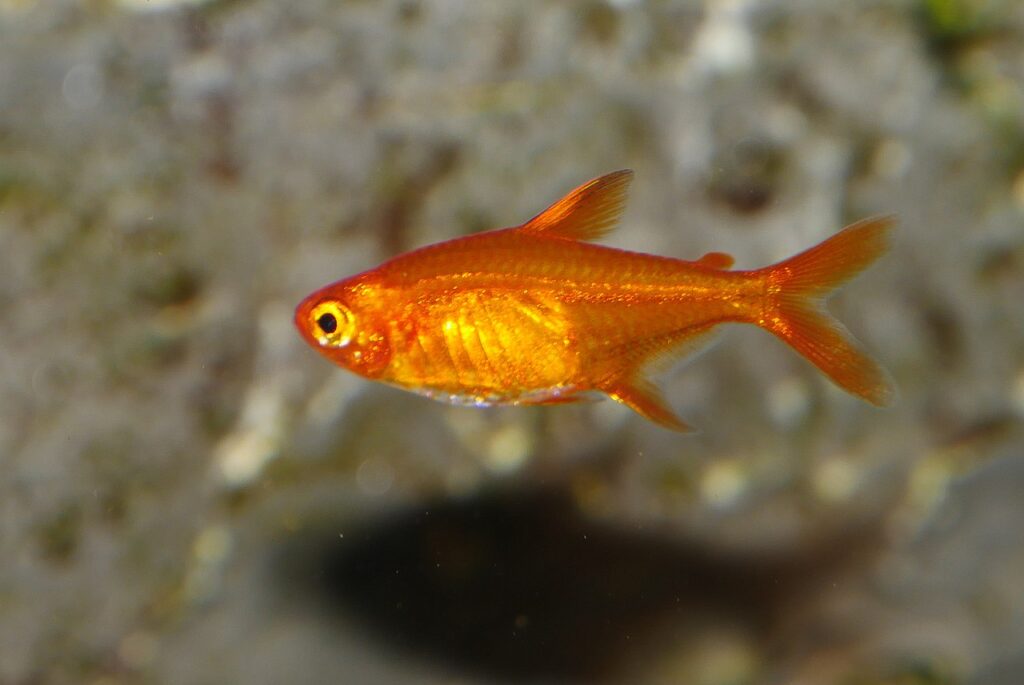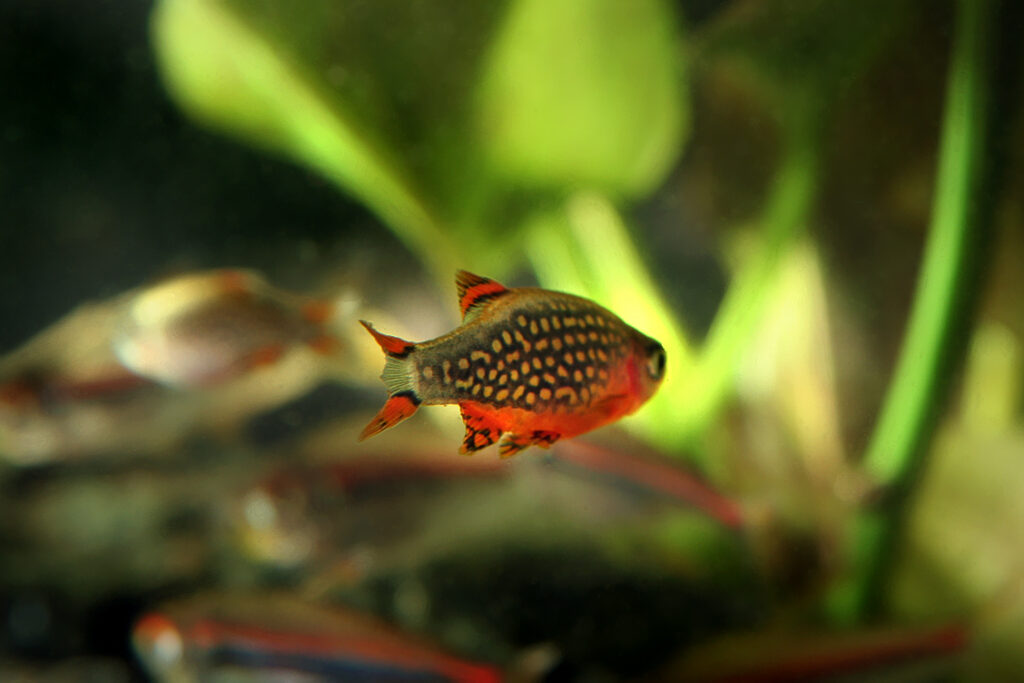In the vast world of aquarium fish, the Dwarf Corydoras (Corydoras hastatus) stands out as a charming and fascinating species. These tiny catfish, also known as Tail Spot Cory or Micro Cory, belong to the Callichthyidae family and are native to the slow-moving streams and rivers of South America, particularly in Brazil and Peru.
Table of Contents
One of the most intriguing aspects of Dwarf Corydoras is their diminutive size. Measuring just 1.4 inches (3.5 cm) in length, these fish are among the smallest of the Corydoras genus, making them perfect for nano tanks and small aquariums. Despite their size, they are full of personality and are sure to capture the hearts of aquarists.
Dwarf Corydoras are bottom-dwellers, spending most of their time scavenging for food and exploring the substrate. They are omnivores and enjoy a varied diet consisting of high-quality sinking pellets, frozen bloodworms, and the occasional blanched vegetable. In their natural habitat, they feed on small invertebrates, detritus, and plant matter.
These peaceful and social fish thrive in groups of at least six individuals, as they find comfort and security in numbers. When kept in a shoal, Dwarf Corydoras exhibit fascinating behaviors, such as playfully chasing each other and engaging in synchronized swimming patterns. Their gentle nature makes them excellent tank mates for other peaceful species, such as small tetras, rasboras, and shrimp.
Creating the perfect home for Dwarf Corydoras is essential for their well-being. They prefer a well-planted aquarium with a soft, sandy substrate that won’t damage their delicate barbels. Driftwood and rocks can be added to provide hiding spots and create a natural-looking environment. Maintaining stable water parameters is crucial, with a temperature range of 72-79°F (22-26°C), a pH between 6.0 and 7.5, and low to moderate hardness.
Did you know that Dwarf Corydoras have a unique defense mechanism? When threatened, they can emit a mild toxin from their skin, deterring potential predators. However, this toxin is harmless to humans and other fish in the aquarium.
Throughout history, Dwarf Corydoras have captivated aquarists with their adorable appearance and endearing behavior. First described by J.P.C. Meinken in 1933, these fish have become increasingly popular in the aquarium trade, with many hobbyists dedicating entire tanks to showcasing their beauty.

Key Information
Dwarf Corydoras (Corydoras hastatus) are small, charming catfish that captivate aquarists with their unique appearance and lively personalities. These fish showcase a delicate balance of colors, with a pale silver to olive-green body adorned with a striking dark band that extends from the dorsal fin to the base of the caudal fin. Their fins are translucent, adding to their overall elegance and grace.
| Family | Callichthyidae |
| Origin | South America (Brazil, Peru) |
| Price | $2 to $5 per fish |
| Common Names | Dwarf Corydoras, Tail Spot Cory, Micro Cory |
| Variants | None |
| Ideal Tank Size | 10 gallons or larger |
| Water Parameters | Temperature: 72-79°F (22-26°C), pH: 6.0-7.5, Hardness: Low to moderate |
| Lifespan | 3 to 5 years |
| Full Size | 1.4 inches (3.5 cm) |
| Natural Environment | Slow-moving streams and rivers |
| Behavior | Peaceful, social, bottom-dwelling |
| Habitat Preference | Well-planted aquariums with soft, sandy substrate |
| Aquarium Decoration | Driftwood, rocks, plants |
| Ideal Tank Mates | Small, peaceful fish (tetras, rasboras, shrimp) |
| Fish to Avoid | Large, aggressive fish that may prey on them |
| Best Foods/Diet | High-quality sinking pellets, frozen bloodworms, blanched vegetables |
| Disease | Susceptible to common fish diseases if water quality is poor |
| Sex-Switch | Does not change sex |
| Gender Differences | Difficult to distinguish; females may be slightly larger and rounder |
| Care Level | Easy |
| Breeding Level | Moderate |
Ideal Tank Mates
When creating a harmonious and thriving aquarium community, selecting the right tank mates for your Dwarf Corydoras (Corydoras hastatus) is essential. These peaceful and social catfish require companions that share similar temperaments, size, and environmental preferences to ensure a stress-free and healthy living environment.
Ideal tank mates for Dwarf Corydoras should be non-aggressive, small in size, and adaptable to the same water conditions. They should also occupy different levels of the aquarium, as Dwarf Corydoras are primarily bottom-dwellers. By carefully choosing compatible species, you can create a diverse and visually appealing aquatic ecosystem that showcases the unique characteristics of each fish.
Here are 15 ideal tank mates for Dwarf Corydoras, along with explanations of why they are compatible:
1. Neon Tetras (Paracheirodon innesi)

Neon Tetras are small, peaceful, and colorful fish that occupy the middle and upper levels of the aquarium. Their vibrant colors and active swimming behavior complement the more subdued appearance and bottom-dwelling nature of Dwarf Corydoras.
2. Cherry Barbs (Puntius titteya)

Cherry Barbs are small, peaceful fish that adapt well to the same water conditions as Dwarf Corydoras. They are active swimmers and add a pop of color to the aquarium without disturbing the Corydoras.
3. Harlequin Rasboras (Trigonostigma heteromorpha)

Harlequin Rasboras are small, schooling fish that are peaceful and easy to care for. They occupy the middle and upper levels of the aquarium, providing a visually appealing contrast to the bottom-dwelling Dwarf Corydoras.
4. Ember Tetras (Hyphessobrycon amandae)

Ember Tetras are tiny, peaceful fish that thrive in similar water conditions as Dwarf Corydoras. Their vibrant red coloration adds visual interest to the aquarium, while their small size ensures they won’t outcompete the Corydoras for food.
5. Pygmy Corydoras (Corydoras pygmaeus)

Pygmy Corydoras are another species of small, peaceful catfish that can coexist harmoniously with Dwarf Corydoras. They share similar preferences in terms of habitat and diet, making them perfect companions.
6. Endler’s Livebearers (Poecilia wingei)

Endler’s Livebearers are small, colorful, and peaceful fish that adapt well to the same water conditions as Dwarf Corydoras. They occupy the upper levels of the aquarium and add visual interest without disturbing the Corydoras.
7. Celestial Pearl Danios (Danio margaritatus)

Celestial Pearl Danios are small, peaceful fish with a stunning appearance. They are active swimmers that occupy the middle and upper levels of the aquarium, providing a beautiful contrast to the Dwarf Corydoras.
8. Lambchop Rasboras (Trigonostigma espei)

Lambchop Rasboras are small, peaceful schooling fish that thrive in similar water conditions as Dwarf Corydoras. Their unique shape and coloration make them an attractive addition to the aquarium.
9. Chili Rasboras (Boraras brigittae)

Chili Rasboras are tiny, peaceful fish that are well-suited for nano tanks and community aquariums with Dwarf Corydoras. Their vibrant red coloration and active swimming behavior add visual interest to the upper levels of the aquarium.
10. Kuhli Loaches (Pangio kuhlii)

Kuhli Loaches are peaceful, eel-like fish that share the bottom level of the aquarium with Dwarf Corydoras. They are nocturnal and help keep the substrate clean by scavenging for leftover food.
11. Otocinclus Catfish (Otocinclus spp.)

Otocinclus Catfish are small, peaceful algae-eaters that can help maintain a clean aquarium environment. They are compatible with Dwarf Corydoras and share similar preferences in terms of habitat and water conditions.
12. Red Cherry Shrimp (Neocaridina davidi)
Red Cherry Shrimp are small, peaceful invertebrates that can coexist with Dwarf Corydoras. They help keep the aquarium clean by grazing on algae and uneaten food, and their bright red color adds visual interest to the tank.
13. Amano Shrimp (Caridina multidentata)
Amano Shrimp are larger, peaceful shrimp that are excellent algae-eaters. They are compatible with Dwarf Corydoras and help maintain a clean and healthy aquarium environment.
14. Dwarf Gouramis (Trichogaster lalius)

Dwarf Gouramis are peaceful, colorful fish that occupy the upper levels of the aquarium. They are compatible with Dwarf Corydoras as long as they have sufficient space and hiding places to minimize territorial disputes.
15. White Cloud Mountain Minnows (Tanichthys albonubes)

White Cloud Mountain Minnows are small, peaceful fish that thrive in similar water conditions as Dwarf Corydoras. They are active swimmers that occupy the middle and upper levels of the aquarium, adding movement and visual interest to the tank.
FAQs
How many Dwarf Corydoras should I keep together?
Dwarf Corydoras are social fish that thrive in groups. It is recommended to keep at least six individuals together to ensure they feel secure and display natural behaviors. However, if you have a larger aquarium, you can keep more Dwarf Corydoras to create an even more impressive shoal.
Can Dwarf Corydoras live with shrimp?
Yes, Dwarf Corydoras can coexist peacefully with most shrimp species, such as Red Cherry Shrimp and Amano Shrimp. These invertebrates can help keep the aquarium clean by grazing on algae and uneaten food, while the Corydoras will not harm them.
How often should I feed my Dwarf Corydoras?
Feed your Dwarf Corydoras small amounts of food two to three times a day. They are omnivores and require a varied diet consisting of high-quality sinking pellets, frozen bloodworms, and the occasional blanched vegetable. Be careful not to overfeed, as this can lead to water quality issues.
Do Dwarf Corydoras need a heater?
Dwarf Corydoras prefer water temperatures between 72-79°F (22-26°C). If your room temperature consistently falls within this range, you may not need a heater. However, if the temperature fluctuates or drops below this range, it is advisable to use an aquarium heater to maintain stable water conditions.
How can I tell if my Dwarf Corydoras are healthy?
Healthy Dwarf Corydoras will have clear eyes, intact fins, and a smooth, unblemished body. They should be active, swimming and foraging throughout the day. If you notice any signs of illness, such as lethargy, loss of appetite, or visible wounds, it is essential to investigate the cause and take appropriate action.
Can I keep Dwarf Corydoras in a planted aquarium?
Absolutely! Dwarf Corydoras thrive in well-planted aquariums, as plants provide them with hiding spots, improve water quality, and create a more natural environment. Just be sure to choose plants that are compatible with the Corydoras’ preferred water conditions and avoid any sharp or abrasive decorations that could injure their delicate barbels.
How long do Dwarf Corydoras live?
With proper care and a well-maintained aquarium, Dwarf Corydoras can live between 3 to 5 years. To ensure your Corydoras reach their full lifespan, maintain stable water parameters, provide a balanced diet, and keep the aquarium clean and free from stress-inducing factors.